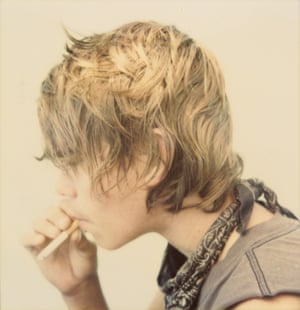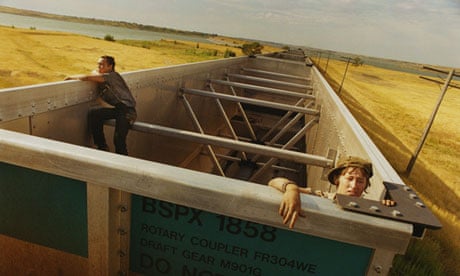Born to run: portraits of American wanderers – in pictures
 Suzanne, an image from the new book Tones of Dirt and Bone. All photographs: Mike Brodie/Twin Palms. Click to view full image
Suzanne, an image from the new book Tones of Dirt and Bone. All photographs: Mike Brodie/Twin Palms. Click to view full imageSean O'Hagan
Thursday 26 March 2015 10.51 EDTLast modified on Thursday 26 March 201510.54 EDT
Mike Brodie came to public attention in 2004 after he started posting pictures online under the alias the Polaroid Kid. Back then, his story seemed too good to be true: a drifter with a Polaroid camera who captured the itinerant lives of the photogenic young people he met as he rode freight trains across the US.
Those early shots of kids who looked like hipster hobos were unashamedly romantic, and made all the more so by their soft Polaroid colours. Initially, Brodie shot on a Polaroid SX-70, given to him by a friend (the first picture he took was of his BMX bike). When the company stopped producing film, he switched to a Nikon F3, all the while creating homemade photobooks. “Brodie leapt into the life of picture-making as if he was the first to do it,” wrote the photographerDanny Lyon. “He was doing what he loved, and he did it compulsively.” Brodie’s Nikon pictures were published in his book A Period of Juvenile Prosperity, by the art-publishing house Twin Palms.

FacebookTwitterPinterest Corey Vinegar smoking in his tent
It all began in 2003 when, on a whim, Brodie dropped out of high school in Florida and rode a freight train to see how far it would take him. Only three days later, he was back home, but the lure of the hobo lifestyle kept calling. He rode the rails illegally, off and on, for the next five years. “A lot of the kids I knew have since gone back to their old lives,” he told me in 2013. “It was something they did, for whatever reason, before they settled down. Some were running away, some were out for adventure. It’s like being homeless by choice.”
Brodie acknowledges the issue of whether this kind of subject matter should be repackaged in expensive artbook form or hung on gallery walls. “You have two worlds colliding right there,” he said. Most of his subjects, he had said, were happy the photos were finding an audience.

FacebookTwitterPinterest Hayes and baby boot

Mike Brodie's freight-train photographs: 'It's a romantic life, at least in the spring and summer'
Read more
Two worlds also collide in his new book, Tones of Dirt and Bone, featuring photographs – many of which are Polaroids – taken between 2004 and 2006. They seem more considered, more artfully poetic even, than those in his previous collection. Brodie has an unerring eye for haunting landscapes and even more haunting – sometimes haunted – faces. A girl in a fur hat stares sideways at his camera, her grazed face and chapped lips suggesting a hard life lived at considerable cost. On the opposite page, though, a boy with long hair in a peaked cap and hippy threads could easily come from the cover of an album by Devendra Banhart. Brodie’s Polaroid romanticism is his great strength, but you wonder if it sometimes conceals more than it illuminates about the hard lives of his subjects. His photos walk the line between pure tenderness and true grit, and one cannot help sensing that there is a degree of mythologising at work.
But there is much to admire. Self-taught and naturally talented, Brodie often homes in on telling details: an adolescent neck dappled with love bites; a child’s small battered boot tucked between the even more battered boots of a parent; alone wooden cross, strewn with flowers and soft toys, with the word “SON” handwritten on it. These are the fragments he has gathered in his itinerant existence, each one a signifier of a community beyond the realms of traditional society.

FacebookTwitterPinterest Hickeys on my neck
There is a melancholy undertow to his best pictures – a sense of loss, and a sense of lives surrendered to drift, survival and danger. The objects and landscapes he photographed all carry a similar sense of mystery: a bunch of leafy flowers, or a dead bird held in an outstretched hand; a railway track or a wintery road disappearing into the horizon. Everything is bathed in the soft, nostalgic tones that made Polaroid film such an evocative medium.
These days, Mike Brodie has settled down. He lives with his wife, Celeste, in California, where he works as a mechanic. In Tones of Dirt and Bone, he wrote: “The photos? I want people to see them just as I want to tell someone a good story … And when I’m dead, maybe my lungs will still be around, with some words beneath: ‘Everything comes as a surprise – thank God.’”
No comments:
Post a Comment